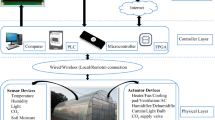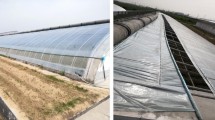Abstract
The solar greenhouse is a typical greenhouse type in northern China. It provides a favorable environment for the growth of various plants and extends cultivation periods for almost a whole year to achieve a high yield. However, indoor environmental control is primarily based on growers’ experience, and the objective test data required for the complex climate control and management of greenhouses are lacking. The present study used three greenhouses in northwest China as research objects: one greenhouse with mature plants (GH-M), one greenhouse with young plants (GH-Y) and one greenhouse without plants (GH-E). Field tests were performed to investigate microclimate characteristics, such as indoor air temperature, relative humidity, and solar radiation under natural ventilation. The results showed that the maximum temperature difference reached approximately 8.2 °C in the vertical direction, and semiempirical equations for the normalized temperature distribution were obtained. The soil temperature remained constant at a certain depth (0.4 m). The distribution of the relative humidity and solar radiation was analyzed. The current study is helpful for growers to develop better greenhouse climate control strategies for management practices.
Similar content being viewed by others
References
Akrami M, Salah AH, Javadi AA, et al. (2020). Towards a sustainable greenhouse: review of trends and emerging practices in analysing greenhouse ventilation requirements to sustain maximum agricultural yield. Sustainability, 12(7): 2794.
Baille A, Colomer RG, Gonzalez-Real MM (2006). Analysis of intercepted radiation and dry matter accumulation in rose flower shoots. Agricultural and Forest Meteorology, 137: 68–80.
Boulard T, Roy JC, Pouillard JB, et al. (2017). Modelling of micrometeorology, canopy transpiration and photosynthesis in a closed greenhouse using computational fluid dynamics. Biosystems Engineering, 158: 110–133.
Çakır U, Şahin E (2015). Using solar greenhouses in cold climates and evaluating optimum type according to sizing, position and location: A case study. Computers and Electronics in Agriculture, 117: 245–257.
Campen JB, Kempkes FLK, Bot GPA (2009). Mechanically controlled moisture removal from greenhouses. Biosystems Engineering, 102: 424–432.
Chauhan BS (2013). Shade reduces growth and seed production of Echinochloa colona, Echinochloa crus-galli, and Echinochloa glabrescens. Crop Protection, 43: 241–245.
Chen C, Ling H, Zhai ZJ, et al. (2018). Thermal performance of an active-passive ventilation wall with phase change material in solar greenhouses. Applied Energy, 216: 602–612.
Chen J, Ma Y, Pang Z (2020). A mathematical model of global solar radiation to select the optimal shape and orientation of the greenhouses in southern China. Solar Energy, 205: 380–389.
Chu CR, Lan T, Tasi R, et al. (2017). Wind-driven natural ventilation of greenhouses with vegetation. Biosystems Engineering, 164: 221–234.
Chu CR, Lan T (2019). Effectiveness of ridge vent to wind-driven natural ventilation in monoslope multi-span greenhouses. Biosystems Engineering, 186: 279–292.
Dai Y, Shen Z, Liu Y, et al. (2009). Effects of shade treatments on the photosynthetic capacity, chlorophyll fluorescence, and chlorophyll content of Tetrastigma hemsleyanum Diels et Gilg. Environmental and Experimental Botany, 65: 177–182.
Davies R (2000). The impact of globalization on local communities: a case study of the cut-flower industry in Zimbabwe (No. 13). International Labour Office, Southern Africa Multidisciplinary Advisory Team.
Gao H, Zhang T, Fan H, et al. (2020). Quantitative Analysis of the factors affecting ecological environment quality in Yangling Demonstration Zone based on geographical detector. Journal of Northwest Forestry University, 35(5): 185–194 (in Chinese).
Ghasemi Mobtaker H, Ajabshirchi Y, Ranjbar SF, et al. (2016). Solar energy conservation in greenhouse: Thermal analysis and experimental validation. Renewable Energy, 96: 509–519.
Giacomelli GA (2002). Considerations for energy management of greenhouse heating and cooling. In: Proceedings of Southern Greenhouse Vegetable Growers Association Conference, Shreveport, LA. USA.
Hou Y, Li H, Li A (2019). Experimental and theoretical study of solar chimneys in buildings with uniform wall heat flux. Solar Energy, 193: 244–252.
Kuroyanagi T (2017). Investigating air leakage and wind pressure coefficients of single-span plastic greenhouses using computational fluid dynamics. Biosystems Engineering, 163: 15–27.
Li X, Wang G, Xue X, et al. (2008). Effects of different wind speeds in greenhouse on growth and transpiration of potted sweet pepper. Transactions of the CSAE, 24(2): 214–218. (in Chinese)
Li T (2013). Theory and Practice on Vegetable Cultivation in Solar Greenhouse. Beijing: Agricultural Press of China. (in Chinese)
Li A, Huang L, Zhang T (2017). Field test and analysis of microclimate in naturally ventilated single-sloped greenhouses. Energy and Buildings, 138: 479–489.
Mashonjowa E, Ronsse F, Milford JR, et al. (2013). Modelling the thermal performance of a naturally ventilated greenhouse in Zimbabwe using a dynamic greenhouse climate model. Solar Energy, 91: 381–393.
Ould Khaoua SA, Bournet PE, Migeon C, Boulard T, Chassériaux G (2006). Analysis of greenhouse ventilation efficiency based on computational fluid dynamics. Biosystems Engineering, 95: 83–98.
Pakari A, Ghani S (2019). Airflow assessment in a naturally ventilated greenhouse equipped with wind towers: numerical simulation and wind tunnel experiments. Energy and Buildings, 199: 1–11.
Ruiz-Nieves JM, Ayala-Garay OJ, Serra V, et al. (2021). The effects of diurnal temperature rise on tomato fruit quality. Can the management of the greenhouse climate mitigate such effects? Scientia Horticulturae, 278: 109836.
Saberian A, Sajadiye SM (2019). The effect of dynamic solar heat load on the greenhouse microclimate using CFD simulation. Renewable Energy, 138: 722–737.
Sarkodie SA, Strezov V, Weldekidan H, et al. (2019). Environmental sustainability assessment using dynamic autoregressive-distributed lag simulations—Nexus between greenhouse gas emissions, biomass energy, food and economic growth. Science of The Total Environment, 668: 318–332.
Sethi VP, Sharma SK (2007). Survey of cooling technologies for worldwide agricultural greenhouse applications. Solar Energy, 81: 1447–1459.
Soni P, Salokhe VM, Tantau HJ (2005). Effect of screen mesh size on vertical temperature distribution in naturally ventilated tropical greenhouses. Biosystems Engineering, 92: 469–482.
Stanciu C, Stanciu D, Dobrovicescu A (2016). Effect of greenhouse orientation with respect to E-W axis on its required heating and cooling loads. Energy Procedia, 85: 498–504.
Tang Y, Ma X, Li M, et al. (2020). The effect of temperature and light on strawberry production in a solar greenhouse. Solar Energy, 195: 318–328.
Vadiee A, Martin V (2012). Energy management in horticultural applications through the closed greenhouse concept, state of the art. Renewable and Sustainable Energy Reviews, 16: 5087–5100.
Vadiee A, Martin V (2013). Energy analysis and thermoeconomic assessment of the closed greenhouse — The largest commercial solar building. Applied Energy, 102: 1256–1266.
Villagrán EA, Baeza Romero EJ, Bojacá CR (2019). Transient CFD analysis of the natural ventilation of three types of greenhouses used for agricultural production in a tropical mountain climate. Biosystems Engineering, 188: 288–304.
Villagran E, Bojacá C (2020). Experimental evaluation of the thermal and hygrometric behavior of a Colombian greenhouse used for the production of roses (Rosa spp.). Ornamental Horticulture, 26: 205–219.
Villagran E, Leon R, Rodriguez A, et al. (2020). 3D numerical analysis of the natural ventilation behavior in a Colombian greenhouse established in warm climate conditions. Sustainability, 12: 8101.
Wei B, Guo S, Wang J, et al. (2016). Thermal performance of single span greenhouses with removable back walls. Biosystems Engineering, 141: 48–57.
Yang Z, Zou Z, Wang J, et al. (2007). Effects of air speed in greenhouse on the growth of muskmelon plants. Transactions of the CSAE, 23(3): 198–201. (in Chinese)
Yang C, Gao T, Li A, et al. (2021). Buoyancy-driven ventilation of an enclosure containing a convective area heat source. International Journal of Thermal Sciences, 159: 106551.
Zhang T (2006). Numerical simulation and experimental research on microclimate environment in greenhouse—Take greenhouses of Shandong Shouguang as examples. Master Thesis, Xi’an University of Architecture and Technology, China. (in Chinese)
Zhang G, Fu Z, Yang M, et al. (2019). Nonlinear simulation for coupling modeling of air humidity and vent opening in Chinese solar greenhouse based on CFD. Computers and Electronics in Agriculture, 162: 337–347.
Zhao Y, Teitel M, Barak M (2001). SE—structures and environment: Vertical temperature and humidity gradients in a naturally ventilated greenhouse. Journal of Agricultural Engineering Research, 78: 431–436.
Acknowledgements
This paper was supported by the National Natural Science Foundation of China (No. 50778145, No. 51478377).
Author information
Authors and Affiliations
Corresponding author
Rights and permissions
About this article
Cite this article
Hou, Y., Li, A., Li, Y. et al. Analysis of microclimate characteristics in solar greenhouses under natural ventilation. Build. Simul. 14, 1811–1821 (2021). https://doi.org/10.1007/s12273-021-0771-1
Received:
Revised:
Accepted:
Published:
Issue Date:
DOI: https://doi.org/10.1007/s12273-021-0771-1




